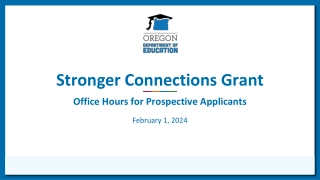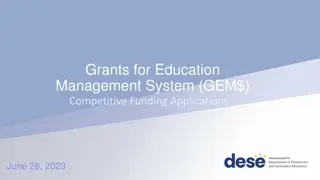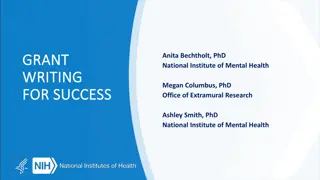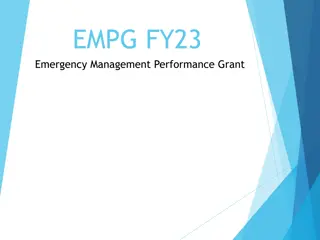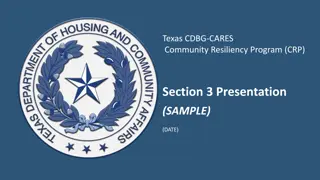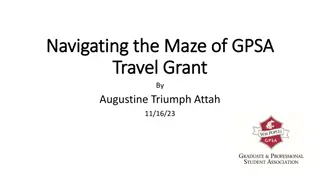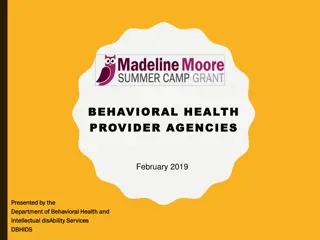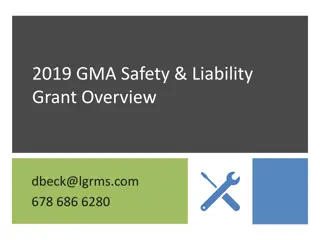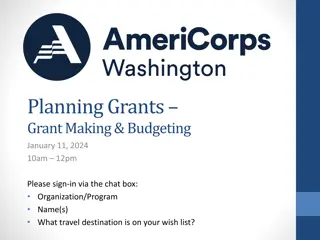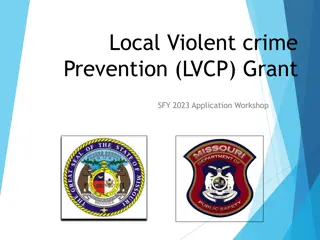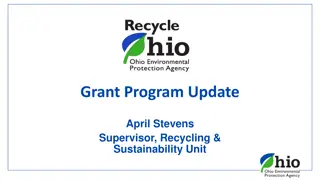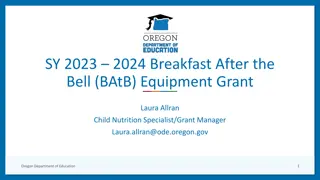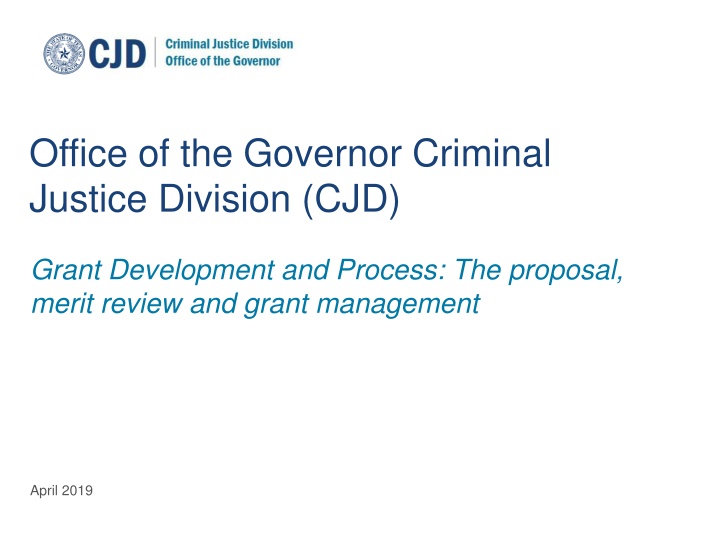
Criminal Justice Grant Development and Management Process Overview
Learn about the grant development process, merit review, and management of grants by the Office of the Governor Criminal Justice Division (CJD). Explore the goals and values guiding funding decisions, the role of the Specialty Court Advisory Council, and the detailed procedure for merit reviews. Understand the importance of quality, performance, and accountability in funding decisions for successful projects.
Download Presentation

Please find below an Image/Link to download the presentation.
The content on the website is provided AS IS for your information and personal use only. It may not be sold, licensed, or shared on other websites without obtaining consent from the author. If you encounter any issues during the download, it is possible that the publisher has removed the file from their server.
You are allowed to download the files provided on this website for personal or commercial use, subject to the condition that they are used lawfully. All files are the property of their respective owners.
The content on the website is provided AS IS for your information and personal use only. It may not be sold, licensed, or shared on other websites without obtaining consent from the author.
E N D
Presentation Transcript
Office of the Governor Criminal Justice Division (CJD) Grant Development and Process: The proposal, merit review and grant management April 2019
Agenda Opening Opening Welcome & Introductions CJD Grants CJD Grants CJD Goals and Values Merit Review Process The Application The Application Do s and Don ts Common Mistakes Managing Your Grant Managing Your Grant Know your budget Grant Officials and Court Team Questions Questions & Closing & Closing 2
Applications & Merit Review Maritza Ramirez 3
Our goals and values Our growing focuses are on quality and performance We have an obligation to fund projects that are well thought out, demonstrate good practices, and well articulated. We look for applications that use accurate information to form a story. We honor the competitive process and hold applicants accountable by not accepting poor or late applications. We can only meet the trust of the people we serve if we ensure that the projects we fund are useful and successful. There is the growing importance of performance. Due to high demand for funds, we have focused on increasing our capacity to make funding decisions on performance. 4
Specialty Court Advisory Council (SCAC) Sec. 772.0061, Texas Government Code, establishes the Specialty Court Advisory Council Evaluates grant applications and make funding recommendations to CJD Council consists of nine (9) council members appointed by the Governor Makes recommendations to the criminal justice division regarding best practices for specialty courts established under Chapters 122 125 & 129 The SCAC and CJD work together in determining long term goals for the Specialty Courts program 5
Merit Review Overview Procedure for merit review session 1. Review Panels. SCAC members are divided into panels and assigned a role (primary, secondary, tertiary) for each application. 2. Application Packages. Panel participants review assigned applications, with individualized scoring sheets, and benchmark reports. 3. Discussion and Scoring. SCAC members review list of applications and discuss strengths/weaknesses and preliminary scores to determine final score. Members with a COI are asked to step out for the discussion. 4. Tabulation of Scores and Funding Recommendation. Final scores are tabulated by staff and ranked for level of funding based on scores. The SCAC recommends rankings to the Executive Director. 5. Final Approval by Executive Director. The executive director will consider merit review rankings along with other factors and make all final funding decisions. Per Rule 3.9 (a) of the Texas Administrative Code, all funding decisions made by the executive director are final and are not subject to appeal. 6. Office of the Governor Approval. All awards must go through financial, legal, and OOG Executive approval before release. 6
Funding Specialty Court Programs Merit Review Process Quality of application Application narrative scored using scoring sheet Application Significant changes and improvement for continuing projects High Risk Different tracks for low risk and high risk offenders TRAS Not sole factor but one of many Benchmark Data reported by programs Best Practices Seven performance benchmarks recommended by SCAC Benchmark Goal: Provide the SCAC with the necessary information to make an informed recommendation 7
The Application Judge Reyes and Maritza Ramirez 8
Grant application writing tips A few dos and don ts of grant writing Do This Not This Follow the instructions precisely Use data and research to back up what you say Know what the evidence says about your approach and share it Ask someone outside of your organization for feedback Tie your budget to your narrative Submit your application on time Gloss over the instructions and get straight to writing Copy and paste from last year Fail to draw a clear connection between the problem, the activities, and the goals Submit an application that contains easy-to-fix errors Confuse passionate for compelling 9
How to build a grant PROJECT A good application must first be a well-thought-out project WHAT? HOW? Problem Statement What problem do we want to solve? Evidence What practices, or research tell us what is likely to work? Target Population Who do we want to help? Approach What specifically are we going to do to solve the problem? Success Performance What specifically do we want to accomplish? How to measure it? Capabilities What skills, expertise, and bandwidth do we need to succeed? 10
Approach The approach is how the applicant plans to solve the problem and meet their objectives. It is the central core of the application. The project approach and activities section should: Clearly describe, in detail, what the project does so that a lay person could understand Address how this project approach will affect the stated problem Provide enough context to understand how the approach ties to capabilities, evidence-based practices, and performance management Explain why the applicant has chosen the approach Include any relevant timelines 11
Specialty Court Scoresheet Application Scoring Scoring Area Problem Identification Sources Questions Problem Statement, Supporting Data Target Group Activities & Measures Does the applicant demonstrate an awareness and understanding of the problem the court will address? Project Strategy Supporting Data, EBP, Activities & Measures Key components, essential characteristics Does the project approach clearly address the problem? Is the project approach based on EBP? Does the project approach use 10 Key Components and essential characteristics per statute? Performance and Outcomes Measurement Performance and Data Management Does the applicant have the ability and resources to accurately and appropriately measure, analyze and respond to performance data? Do you feel confident that the applicant can successfully manage and execute their plans? Does the applicant have a track record of success? Capacity and Capabilities Capacity & Capability Does the applicant have adequate personnel, experience, capacities, and resources to properly execute the state program goals? 12
Narrative Example Strong or weak? 13
Narrative Example Strong example Teams completed the National Drug Court Planning Institutes' implementation training to incorporate the "Ten Key Components" of Drug Courts. Manualized cognitive behavioral treatment programs are utilized to help participants become honest, change criminal thinking, improve decision making and learn the importance of following rules. Evidenced-based curriculums used include: National Institute of Corrections "Thinking for a Change", Correctional Counseling's Moral Reconciliation Therapies, and Wanburg and Milkman's "Strategies for Self-Improvement and Change". 14
What the Reviewers are looking for Reviewer Scores Common Mistakes What we re looking for Application is too vague and does not provide enough detail. Application does not answer the questions and fails to provide sufficient information.. Application does not include any updated information carbon copy. Incorrect performance measures. Proposal does not match benchmark report. Application does not clearly convey program successes or performance. Contradicting information. Application has clear understanding of problem, supporting data, target group and project approach. Project approach is based on evidence based practices and addresses the problem. Well written, clear application with good data supporting the need. Application matches benchmarks. Data is being tracked and Benchmarks show results. Details are provided (i.e. follow 10 key components, PO s receive training in MI, TRAS is used, credentials are listed, etc.) Updated information including information on how program has evolved with the times. Applicant shows they have capacity & capability to execute the stated program goals. 15
Key Takeaways Tell a story and stick to it Clearly define the root problem Tell your story Supporting data Goals, objectives & measures Tell your story Target population Evidence Based Practices Collect, track & maintain data Brag about capabilities Details Know what your grant writer is saying about your program 16
Grant Management Maritza Ramirez and Kristen Lenz 17
Collaboration is Key Share, exchange, assist and support Court Team Grant Officials 18
Grant Officials & Court Team Roles GRANT OFFICIALS COURT TEAM Track, manage and assess program s measures and successes. Track, manage and prepare projections for all aspects of a program s grant funded budget Communicate directly with grant officials. Communicate directly with funder and court program staff Track, manage and assess program s needs Maintain positive collaborative relations with court program team and CJD 19
Compliance Know your budget Allowable Costs Fund Holds Balance 20
Criminal Justice Division (CJD) Resources for Applicants and Grantees Online Services Office of the Governor, Public Safety Office, Criminal Justice Division website https://gov.texas.gov/organization/cjd/criminal-justice-division Links to all CJD Programs Best Practices Additional resources eGrants online grant application and management system https://egrants.gov.texas.gov/Default.aspx Guide to Grants - information on applying for and managing grants https://gov.texas.gov/uploads/files/organization/criminal-justice/Guide-to-Grants-2018.pdf 21

